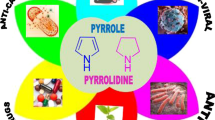Abstract
A series of 4-(2,5-dimethylpyrrol-1-yl)/4-pyrrol-1-yl benzoic acid hydrazide analogs, some derived 1,3,4-oxadiazoles, 5-substituted-4-amino-1,2,4-triazolin-3-thione and 2,5-dimethyl pyrroles have been synthesized in good yields and structures of these compounds were established by IR, 1H NMR, 13C NMR, Mass spectral and elemental analysis. These compounds were evaluated for their preliminary in vitro antibacterial, antifungal and antitubercular activities against Mycobacterium tuberculosis H37Rv strain by broth dilution assay method. Twelve of these compounds displayed good antimicrobial activity, with a minimum inhibitory concentration (MIC) values 1–4 μg mL−1. Several compounds 4, 8d, 9, 12c–d and 12f–h exhibited good in vitro antitubercular activity with MIC values 1–2 μg mL−1. Further, some title compounds were also assessed for their cytotoxic activity (IC50) against mammalian Vero cell lines and A549 (lung adenocarcinoma) cell lines using MTT assay method. The results reveal that these compounds exhibit antitubercular activity at non-cytotoxic concentrations.
Graphical Abstract
Synthesis, spectral studies and antibacterial, antifungal and antitubercular activities of a novel series of pyrrole derivatives are described



Similar content being viewed by others
References
Biava M, Fioravanti R, Porretta GC, Deidda D, Maullu C, Pompei R (1999) New pyrrole derivatives as antimycobacterial agents analogs of BM 212. Biorg Med Chem Lett 9:2983–2988
Das RK (2000) Tuberculosis-historical landmarks. J Indian Med Assoc 98:112–114
Demirayak S, Karaburun AC, Kiraz N (1999) Synthesis and antibacterial activities of some 1-[2-(substituted pyrrol-1-yl)ethyl]-2-methyl-5-nitroimidazole derivatives. Eur J Med Chem 34:275–278
Demirayak S, Karaburun AC, Beis R (2004) Some pyrrole substituted aryl pyridazinone and phthalazinone derivatives and their antihypertensive activities. Eur J Med Chem 39:1089–1095
Desai NC, Shukla K, Thaker KA (1984) Some new 2-aryl-3-isonicotamido-4-thiazolidinones and their 5-carboxymethy homologues as potential antitubercular and antibacterial agents. J Indian Chem Soc 61:239–240
Desai B, Sureja D, Naliapara Y, Shah A, Saxena AK (2001) Synthesis and QSAR studies of 4-substituted phenyl-2,6-dimethyl-3, 5-bis-N-(substituted phenyl)carbamoyl-1,4-dihydropyridines as potential antitubercular agents. Bioorg Med Chem 9:1993–1998
Dutt AK, Stead WW (1999) In: David S (ed) Tuberculosis and nontuberculosis mycobacterial infections, 4th edn. W.B. Saunders, Pennsylvania, p 3
Dye C (2002). 4th World congress on tuberculosis, Washington, DC. June 3–5
Goto S, Jo K, Kawakita T, Mitsuhashi S, Nishino T, Ohsawa N, Tanami H (1981) Determination method of minimum inhibitory concentrations. Chemother Chemother 29:76–79
Gundersen LL, Nissen-Meyer J, Spilsberg B (2002) Synthesis and antimycobacterial activity of 6-arylpurines: the requirements for the N-9 substituent in active antimycobacterial purines. J Med Chem 45:1383–1386
Jones RA (1992) Pyrroles, part II, the chemistry of heterocyclic compounds, vol 48. Wiley, New York, pp 131–298
Jones RA, Bean GP (1997) The chemistry of pyrroles. Academic Press, London, pp 51–57
Joshi SD, Vagdevi HM, Vaidya VP, Gadaginamath GS (2008a) Synthesis of new 4-pyrrol-1-yl benzoic acid hydrazide analogs and some derived oxadiazole, triazole and pyrrole ring systems, a novel class of potential antibacterial and antitubercular agents. Eur J Med Chem 43:1989–1996
Joshi SD, Vagdevi HM, Vaidya VP, Gadaginamath GS, Purohit SS (2008b) Synthesis and antibacterial and antitubercular activities of some new 3-substituted phenyl-5-(4-pyrrol-1-ylphenyl)-4H-1,2,4-triazole derivatives. Indian J Heterocycl Chem 17:367–368
Joshi SD, Joshi Ashwini, Vagdevi HM, Vaidya VP, Gadaginamath GS (2010) Microwave assisted synthesis of some new quinolinylpyrrole derivatives as potential antibacterial and antitubercular agents. Indian J Heterocycl Chem 19:221–224
Khalil MA, El-Sayed OA, El-Shamny HA (1993) Synthesis of certain 2-aminoadamantane derivatives as potential antimicrobial agents. Arch Pharm 326:489–492
Maher D, Floyd K, Raviglione M (2002) Strategic framework to decrease the burden of TB/HIV. World Health Organization, Geneva
Martien WB, Floyd K, Broekmans JF (2002) Interventions to reduce tuberculosis mortality and transmission in low- and middle-income countries. Bull World Health Organ 80:217–227
Mosmann T (1983) Rapid colorimetric assay for cellular growth and survival: application to proliferation and cytotoxicity assays. J Immunol Methods 65:55–63
Rouhi AM (1999) Tuberculosis: a tough adversary. In Chem Eng News 77:52–70
Shah RR, Mehta RD, Parikh AR (1985) Studies on isoniazid derivatives. Preparation and antimicrobial activity of 2-aryl-3-(pyridylcarbomyl)-5-carboxymethyl-4-thiazolidinones. J Indian Chem Soc 62:255–257
Sriram D, Yogeeswari P, Madhu K (2005) Synthesis and in vitro antimycobacterial activity of some isonicotinoyl hydrazones. Bioorg Med Chem Lett 15:4502–4505
Sriram D, Yogeeswari P, Madhu K (2006) Synthesis and in vitro antitubercular activity of some 1-[(4-sub)phenyl]-3-(4-{1-[(pyridine-4-carbonyl)hydrazono]ethyl phenyl) thiourea. B. Bioorg Med Chem Lett 16:876–878
Suling WJ, Seitz LE, Pathak V, Westbrook L, Barrow EW, Ginkel SZV, Reynolds RC, Robert Piper J, Barrow WW (2000) Antimycobacterial activities of 2,4-diamino-5-deazapteridine derivatives and effects on mycobacterial dihydrofolate reductase. Antimicrob Agents Chemother 44:2784–2793
Suresh Kumar GV, Rajendraprasad Y, Mallikarjuna BP, Chandrashekar SM, Kistayya C (2010) Synthesis of some novel 2-substituted-5-[isopropylthiazole] clubbed 1,2,4-triazole and 1,3,4-oxadiazoles as potential antimicrobial and antitubercular agents. Eur J Med Chem 45:2063–2074
Vigorita MG, Maccari R, Ottana R, Monforte F (1999) Lipophilic analogs of isoniazid with antiproliferative in vitro activity. Med Chem Res 9:306–321
Yajko DM, Madej JJ, Lacaster MV, Sanders CA, Cawthon VL, Gee B, Babst A, Keith Hardley W (1995) Colorimetric method for determining MICs of antimicrobial agents for Mycobacterium tuberculosis. J Clin Microbiol 33:2324–2327
Acknowledgments
We thank Shri. H. V. Dambal, President, S. E. T’s College of Pharmacy, Dharwad, Karnataka, India, for providing necessary facilities. We are thankful to Dr. A. M. Godbole for his valuable suggestions and appreciate the co-operation of Mr. Uttam More in the preparation of this manuscript. We are grateful to Dr. K. G. Bhat, Maratha Mandal’s Dental College, Hospital and Research Centre, Belgaum, Karnataka, India for providing the facilities for antibacterial and antitubercular activities. We also wish to thank Director, SAIF, Indian Institute of Technology, Chennai, India and Director, USIC, Karnataka University Dharwad, India for providing NMR and Mass spectral data.
Author information
Authors and Affiliations
Corresponding author
Rights and permissions
About this article
Cite this article
Joshi, S.D., More, Y., Vagdevi, H.M. et al. Synthesis of new 4-(2,5-dimethylpyrrol-1-yl)/4-pyrrol-1-yl benzoic acid hydrazide analogs and some derived oxadiazole, triazole and pyrrole ring systems: a novel class of potential antibacterial, antifungal and antitubercular agents. Med Chem Res 22, 1073–1089 (2013). https://doi.org/10.1007/s00044-012-0112-0
Received:
Accepted:
Published:
Issue Date:
DOI: https://doi.org/10.1007/s00044-012-0112-0




